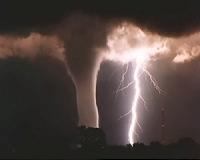| . |  |
. |
Geneva (AFP) Aug 18, 2010 Climate scientists must urgently look into changes in atmospheric currents linked to devastating floods in Pakistan and wildfires in Russia, UN climate and weather bodies said on Wednesday. Ghassem Asrar, director of the World Climate Research Programme, told AFP that changes, known as blocking episodes, can prevent humidity or hot weather dispersing. That intensified heavy rain or heatwaves and locked them over an area, he explained, potentially with a growing impact on extreme weather events that scientists expect to happen more frequently with global warming. Asrar said that European researchers had modelled the blocking pattern in atmospheric currents and resulting weather behind the Pakistani rains and Russian heatwave a few weeks in advance. They "clearly flagged this formation and kept track of it", said Asrar, whose programme is partly linked to the UN's World Meteorological Organisation (WMO). "We know for sure that the two events in Pakistan and Russia are linked," he added. Asrar and the WMO underlined that the intense monsoon rain in Pakistan and heatwave in Russia, as well as rain-induced landslides in China and the split of a giant iceberg in Greenland in recent weeks were exceptional even by the standards of naturally-occurring climate extremes. The WMO called the four "an unprecedented sequence of events" that "compare with, or exceed in intensity, duration or geographical extent, the previous largest historical events". "This poses an urgent question for climate science: whether the frequency and longevity of the blocking episodes are going to change," the WMO said in a statement.a The evidence behind the impact and shifts in blocking patterns in atmospheric currents as well as the changing role of disruptive El Nino and La Nina currents over the Pacific Ocean, added to the urgent need for answers, Asrar argued. "Absolutely, because of the impact on life and property, if you look at what happened in Pakistan and China," he added. Scientists are reluctant to overtly blame a single weather event on climate change, which measures longer term shifts over periods of years or decades. Moscow was trapped in an unprecedented heatwave in the past six weeks with temperatures soaring to 40 degrees Celsius (104 degrees Fahrenheit) and daily highs well above 30 degrees (86 F) for a month, triggering a nationwide crisis and destroying a quarter of the country's crops. Asrar said the priorities for climate and weather science were "transforming very rapidly". Meanwhile, experts predict that the highly disruptive La Nina pattern would last at least until early 2011. The phenomenon lasts "usually around nine to 12 months," said Rupa Kumar Kolli, a researcher at the WMO. "At the moment, we don't have really reliable indicators on how long it will last -- at least until the end of this year." "La Nina conditions are expected to strengthen and last through (the) Northern Hemisphere winter," the US National Oceanic and Atmospheric Administration (NOAA) said earlier this month. La Nina is the return swing of El Nino, a weather anomaly that faded in mid-year after being blamed for blizzards in the United States, heatwaves in Brazil, killer floods in Mexico and drought in Argentina. The El Nino/La Nina cycle is caused by a buildup of warm water that surges from the western Pacific to the eastern Pacific before cooling. La Nina is associated with greater-than-usual monsoons in South Asia, drought or water stress in South America and more Atlantic cyclones. The last La Nina was in 2007-8.
Share This Article With Planet Earth
Related Links Weather News at TerraDaily.com
 NASA Lightning Research Happens In A Flash
NASA Lightning Research Happens In A FlashWashington DC (SPX) Aug 10, 2010 Lightning's connection to hurricane intensification has eluded researchers for decades, and for a riveting 40 days this summer, NASA lightning researchers will peer inside storms in a way they never have before. Earth scientists and engineers at NASA's Marshall Space Flight Center in Huntsville, Ala., will soon fly the Lightning Instrument Package, or LIP, a flight instrument designed to t ... read more |
|
| The content herein, unless otherwise known to be public domain, are Copyright 1995-2010 - SpaceDaily. AFP and UPI Wire Stories are copyright Agence France-Presse and United Press International. ESA Portal Reports are copyright European Space Agency. All NASA sourced material is public domain. Additional copyrights may apply in whole or part to other bona fide parties. Advertising does not imply endorsement,agreement or approval of any opinions, statements or information provided by SpaceDaily on any Web page published or hosted by SpaceDaily. Privacy Statement |